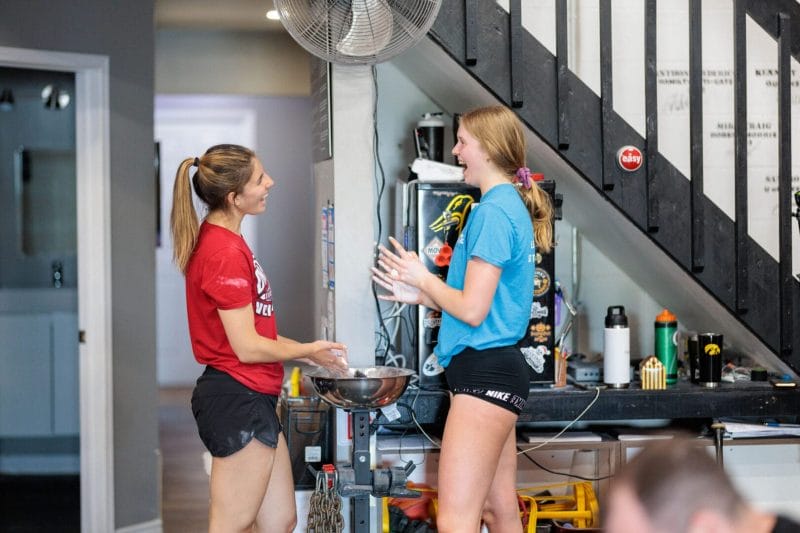Working in the private sector, many of the athletes we train at Iron Performance Center fall between the ages of 13-20 years old. We tend to get a ton of up and coming high school athletes from a variety of backgrounds and experience levels. Working with so many young athletes over the years has led me to see a trend in the style of periodization I tend to fall back on. Regardless of whether it’s considered right or wrong, it’s what I’ve found most effective. In the most general sense (and I mean very general), I’ve found myself drawn towards undulating periodization for the majority of my high school athletes. Here’s why:
1) They’re Always Competing
Many of our high school athletes end up playing for multiple teams across multiple levels, sometimes even multiple sports. Essentially what ends up happening is they never really get a true off-season or break from competition. Now, do I agree with this? No. Is it ideal? No. Regardless of what I think, it happens and will continue to happen at the high school level. So, we have to deal with it.
2) Quicker Transfer of Trainable Qualities
You’ll probably argue that any periodization style can lead to transfer of qualities, and you’d probably be right. That being said, I’ve found we’re able to regulate recovery better with undulating or block style periodization. Furthermore, we make better use of time by focusing on a primary adaptation each phase while maintaining other qualities. Put the two together and you get a better training outcome. Granted, this comes down to sound programming and stress management, however, the undulating ebbs and flows (daily, weekly or monthly) typically align better with “never ending” athletes. Just my two cents.
3) Regulation Of Volume & Intensity
This ties in to my previous points. The name of the game for the never ending athlete is going to be stress management. Can we find ways to mitigate stress to promote recovery while balancing stress necessary for adaptation. Essentially, we need to be able to microdose our training prescriptions and adjust accordingly. Undulating periodization can account for this. We can plan phases with higher stress to elicit adaptation before dropping back to lower stress for optimization (our fancy way of saying recovery). This wave-like pattern (daily, weekly, monthly) allows flexibility.
4) Exercise Practice
Let’s clear the air right off the bat. I know that any high school athlete will see great improvement in measurable qualities by simply practicing the exercises taught to them. This isn’t lost on me. I am simply looking to optimize how we teach the skills with how we regulate volumes and intensities appropriate for their current athletic lifestyle.
While I would agree linear periodization is helpful for skill development, I still find it possible to improve economy of movement while training at volumes/intensities better suited for explosive development. We can teach the movement patterns at lower volumes while adjusting the intent at which we perform them; typically either near max effort or dynamic effort. This allows better quality repetition; lower volume means less fatigue and less deterioration of movement skill. Furthermore, we can usually keep the same set/rep scheme (depending on whether we’re looking to adapt or optimize) and simply change the intent at which we do it.
5) Putting These Points Together
Let’s use an example. Say we have a kid, let’s call him Billy, and he is a “never ending” athlete. He hasn’t trained before and wants to join the iron game. Let’s say we are programming a front squat for Billy. If we teach Billy how to front squat on a 5×3 rep scheme, we can keep that same exercise and scheme and simply change the intent at which we perform it over the coming weeks. We simply undulate the intent and account for volume/intensity as needed.
For the first three weeks, we may have Billy do a 5×3 front squat with the intent of controlling the bottom; we may add a yielding isometric. Let’s say Billy grasps the movement, fantastic, we may do a 5×3 front squat with the intent of getting stronger for the coming 3 weeks. Billy can load up his front squat each week. Then we may drop back the load of the front squat for the following three weeks and we tell Billy to make that bar rattle. We want him to move that bar as fast as possible. Boom, Billy is now focusing on power. The following 3 weeks might see Billy returning back to a strength focus but maybe Billy needs more rest. We cut back to a 3×3 or 3×2 scheme. Then we may undulate back to power with the same scheme. Over time, we’re able to adjust for Billy; undulating variables revolving around intent focus and the minimal effective dose needed for Billy when he needs it.
The point being is that we are able to accommodate Billy (and all the other high school athletes) by simply wave planning his training. Is it perfect? No, but it checks a lot of the boxes needed for young athletes looking to learn how to train while balancing the demands of their life. It’s flexible and allows kids to take these skills and implement the transfer as fast as possible (or as fast as we could hope). Many roads lead to Rome, but this one’s a pretty solid highway.
How We Use Undulating Periodization
If you’re having a hard time visualizing our Billy example, I’ve included a breakdown below of what it may look like in action. Keep in mind we’re balancing a few key factors:
- Volume
- Adaptation (Stress Focus) or Optimization (Recovery Focus)
- Intensity
- Intent Based
- Transferability
- Exercise Selection
Remember, how you choose to undulate phase to phase across the year should be flexible enough to account for human factors associated with training young athletes. You can choose to undulate a single factor (volume, intensity, etc.) or a combination of many in order to better manage their stress. For the “never ending” athlete, a simple wave adjustment of intent is a good focus point throughout the year. Adjust volumes as you see fit to account for higher than normal fatigue or stress.
In Closing
Undulating periodization can be a simple tool to manage the chaos that is the high school athlete on the go. By simply wave planning intent, you can ensure a clear focus when chasing adaptation while balancing recovery throughout the year. Undulating volume and load in smaller phases can help manage stress and mitigate unnecessary fatigue; a necessity when training young athletes who seem to compete year round. Keep it simple, keep it flexible, keep it fun. Watch your kids thrive.
Are you a young athlete looking to elevate your performance? Our staff are happy to help. Click here to schedule a call with us and we’ll get to work!


